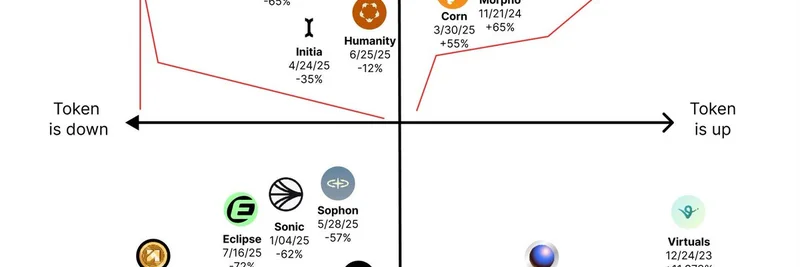In the fast-paced world of crypto, token launches can make or break a project. Recently, Haseeb Qureshi, managing partner at Dragonfly Capital, shared some sharp insights on X (formerly Twitter) about the pitfalls of "big bang" Token Generation Events (TGEs). His thread, responding to a post by Justin Vogel of Safary Club, dives into why hyped launches aren't always the golden ticket and offers timeless advice for builders, especially those in the meme token scene.
Let's break it down. Justin Vogel kicked things off with a bold claim: "Big bang TGEs are dead." He backed it up with a chart analyzing TGEs from the past 18 months, plotting them based on initial hype versus current performance. The visual divides projects into quadrants like "Pessimists win" (strong TGE but token down) and "Believers win" (weak TGE but token up). Tokens like EigenLayer and Berachain landed in the dumps despite strong starts, while outliers like Zora and Virtuals thrived after quiet launches.
Haseeb wasn't buying the narrative wholesale. He pointed out flaws in the data: "This makes no sense. The data here does not tell a clear story." For one, half the "strong TGEs" are actually up, and the "weak TGE" category is underrepresented—there are thousands of low-hype launches out there, making successes like Zora seem like rare gems rather than a foolproof strategy.
What does this mean for meme tokens? Memecoins often mirror these dynamics. Think about it: many meme projects launch with massive hype, snipers jumping in for quick flips, much like Haseeb describes. "If you launch Monad at $500M, it will pop up to multi-billion valuation the next block. You're just giving away money to snipers. It's no different from memecoin launches or NFT mints." The market sets the price, hype or not. In the meme world, where community and virality drive value, starting small and building organic adoption could be the smarter play—accruing value over time instead of chasing an explosive debut that fizzles fast.
Haseeb acknowledges the current market vibe: hot money shifting from alts to equities in 2025 has hit TGEs hard. But he reminds us that crypto is cyclical. "People have short memories in crypto," he says, noting how alts have bounced back before. For meme token creators, this is a call to patience. Focus on fundamentals: build a product users love, nurture your community, and don't obsess over token price as your sole metric of success.
Why Meme Tokens Should Pay Attention
Meme coins thrive on narrative and momentum, but Haseeb's critique highlights the risks of overhyping a launch. Projects like Pengu or Corn from the chart show that steady believers can win out. If you're launching a meme token, consider strategies that reward long-term holders rather than short-term speculators. Tools like fair launches on platforms such as Solana or Ethereum can help distribute tokens more equitably, reducing sniper dominance.
Advice for Blockchain Builders
Wrapping up his thoughts, Haseeb offers solid guidance: "Focus on product, retain your team, treat your community well, and don't mistake your token price as your report card." In the meme token ecosystem, where vibes can shift overnight, this rings especially true. Build something authentic, engage genuinely, and trust that real value will shine through— even if it takes longer than expected.
For the full thread, check it out here. If you're diving into meme tokens, staying informed on these debates can give you an edge in this wild market.


